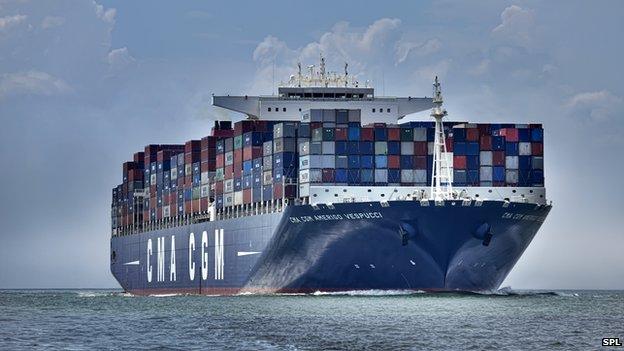Scientists map global routes of ship-borne invasive species
- Published
- comments

The rapid rise in cargo shipping has helped the spread of invasive species around the world
Scientists have developed the first global model that analyses the routes taken by marine invasive species.
The researchers examined the movements of cargo ships around the world to identify the hot spots where these aquatic aliens might thrive.
Marine species are taken in with ballast water on freighters and wreak havoc in new locations, driving natives to extinction.
The research, external is published in the Journal Ecology Letters.
There has been a well-documented, external boom in global shipping over the past 20 years and this has led to growing numbers of species moving via ballast tanks, or by clinging to hulls.
Some ports such as San Francisco and Chesapeake Bay have reported, external several exotic new species arriving every year. Economic estimates indicate , externalthat marine invaders can have huge impacts that last for decades.
Now, scientists from the UK and Germany have developed a model that might help curb these unwanted visitors. They obtained detailed logs from nearly three million voyages that took place in 2007 and 2008.

Scientists mapped the global routes taken by cargo ships over a two-year period
"Our model combines information such as shipping routes, ship sizes, temperatures and biogeography to come up with local forecasts of invasion probabilities," said Prof Bernd Blasius from the University of Oldenburg.
While this is a mathematical model, the researchers were able to adjust it by carrying out field observations. They were able to estimate the probability that a species can survive a journey and establish a population in a subsequent port of call.
"It is called ecological roulette," said Dr Michael Gastner from the University of Bristol.
"The probability of winning from the perspective of the invader is really tiny - but because the number of attempts are now growing with more and bigger ships, you play this roulette so often that you become a likely winner sooner or later," he added.
The team says that the key hotspots for invasion are Singapore, Hong Kong, and the Panama and Suez canals. Cooler climates like the North Sea are less likely to be troubled, unless ships come from similar waters such as the east coast of the US. They conclude that very long trips are less likely to be a cause for concern.
"If you are travelling 20,000 km, it is rather unlikely that an organism will survive this, as ballast water is not the most cosy environment to live in," said Dr Gastner.
"There is a certain intermediate range of distances that you can survive as a potential invader. You are the new kid on the block and can increase your population in a very short time," he added.
While the growth in cargo carried across the oceans means that the risk of future invasions is severe, the researchers say that tackling the ballast water issue can be a powerful means of mitigation.
But Dr Gastner is worried that economic pressure might prevent ship owners from taking the necessary steps.
"There is no single solution that seems to be working on a global scale; different ship sizes have different engineering constraints - and it takes too much time to have the water filtered."
"For the shipping industry, even an extra half an hour in port means additional costs and they are trying to reduce this as much as they can," he said.
Follow Matt on Twitter, external.
- Published15 April 2013
- Published28 April 2013
- Published4 October 2012